The toilet room and its cleanliness are what speak best about the neatness of the owner of the apartment. The modern market offers a rich assortment of all kinds of substances that can easily remove plaque and add neatness and luster to the bathroom. Toilet bowl cleaners easily defeat germs and clean porcelain surfaces. In addition, they greatly facilitate cleaning, making it simple, but at the same time quite effective.
Main types of toilet contamination
Depending on the type of contamination, it is necessary to use appropriate detergents.
Keeping the toilet clean is a top priority, and it is not too difficult to implement. It is important to regularly pay attention to this accessory, otherwise you can wait for a situation where the dirt is firmly embedded and it becomes incredibly difficult to get rid of it.
It is worth noting that usually the following contaminants appear on the surface of the toilet bowl, which housewives have to clean:
- limescale deposits that occur when tap water differs high content salts and a considerable level of hardness. To combat it, you need to use toilet bowl cleaners that contain alkaline substances;
- rust can appear when the pipes through which water flows to the bathroom are not new and clean. Acid can deal with it;
- household contaminants that settle on the surface are removed using substances called surfactants;
- the bad smell caused by breeding bacteria is quickly and easily removed with bleach, as a rule, most of these products contain it. In addition, they contain fragrances that perfectly mask any aroma.
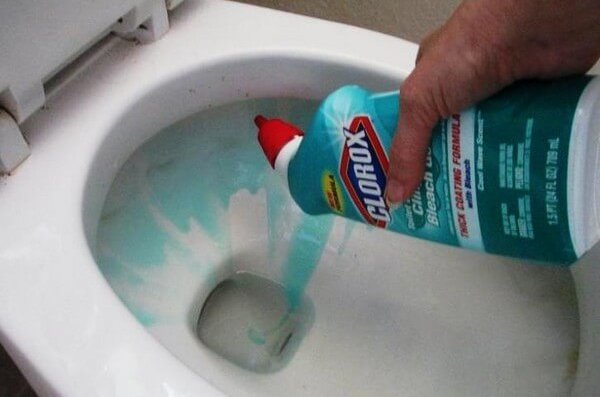
Gel is an economical and easy-to-use toilet cleaner.
It is worth noting that the following substances and means are used to combat pollution of sanitary products:
- Chemically active, which quickly tidy up the surface of the toilet:
- gel: it is perfectly applied to the surface of the toilet bowl, and its structure allows it to slowly spread and carry away all germs and bacteria. As a rule, for the convenience of applying such substances, a bottle with a spout is used, which is bent at a certain angle, which allows you to direct the flow of the product even into hard-to-reach places;
- liquid: a less economical product that quickly drains into water;
- powder: you have to constantly rub it into the walls of the product to clean them. Therefore, they are not very easy to clean;
- cream: gently removes plaque without damaging the surface of the earthenware. Unfortunately, manual application deprives it of consumer popularity.
- Preventive, main task which is the prevention of pollution:

- tablets, washers or cubes that need to be attached to the toilet so that flushed water passes through them, achieving the release of cleaning and refreshing particles;
- magnetic rings that need to be installed directly in the drain tank. They are expensive, but they effectively dissolve contaminants.
- Folk remedies that have no worse ability to deal with unpleasant phenomena:
- soda;
- vinegar.
When choosing a product that helps to effectively clean the bathroom, you should, first of all, pay attention to the most economical ones, which, moreover, can be used without much effort.
The best toilet cleaner

An acid or alkali in the cleaning agent helps remove rust.
Any woman who runs a household is faced with the need to make decisions and choose the best remedy for cleaning the toilet, which removes plaque and gives the whole room a smell of freshness and cleanliness.
It should be noted that a properly selected cleaner copes with the following problems:
- removes contaminants that appear during product operation;
- dissolves lime deposits;
- removes rust marks on the surface;
- disinfects the toilet.
To achieve these goals, the cleansing agent contains the following ingredients:
- Surfactants that fight organic contaminants and are necessary for quality washing toilet. As a rule, non-ionic ones are considered the safest type.
- Acidic or alkaline compounds that make it possible to achieve the dissolution of rust molecules, as well as plaque, which quite often forms on the walls of the product. It is worth noting that they must be handled with extreme caution so as not to burn your hands or mucous membranes.
- Chlorine compounds, which allow you to destroy bacteria and disinfect the bathroom.
Today the following brands are considered the most popular, and therefore effective:
- Cillit Bang. This toilet bowl cleaner is formulated in a gel form, making application easy and convenient. In addition, the container is equipped with a spout that allows you to bring the substance to the most inaccessible places.
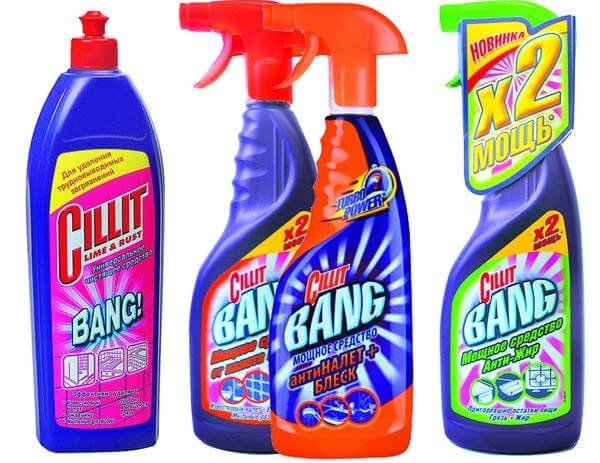
This gel contains hydrochloric acid, which dissolves and removes all contaminants, including rust. However, they must be used with caution, wearing gloves to prevent chemical burns.
The following advantages of using Cillit Bang gel can be noted:
- high efficiency;
- minimum level of spending;
- ergonomic packaging for easy application.
Disadvantages of Cillit Bang gel:
- not the lowest price;
- The product is not equipped with a lid that children cannot open.
- Domestos. This toilet cleaner is also created in the form of a gel, which does an excellent job with rather complex types of pollution. The acid in its composition perfectly dissolves rust spots, as well as fungi and bacteria.

This gel has important advantages:
- its consistency is quite viscous and viscous, which allows it to be evenly distributed over the entire surface of the toilet bowl;
- minimum possible consumption of substances for effective purification;
- equipped with protection against opening by children.
- the presence of a persistent and pungent odor.
- "Comet 7 days of cleanliness." This gel has the ability to keep plumbing cleanliness under control for a whole week. As the manufacturer notes, it is enough to apply it once, after which it does an excellent job of maintaining order for 7 days. The product works thanks to the sulfuric acid it contains.

It is necessary to emphasize its following advantages:
- ability to remove any contaminants;
- low consumption with high efficiency;
- low price;
- prolonged protection of plumbing fixtures;
- a lid that children cannot open.
Disadvantages of the cleaning product:
- Quite a strong smell of chloride component.
- "Toilet duckling" A gel that works on the basis of hydrochloric acid, thereby fighting stubborn stains.
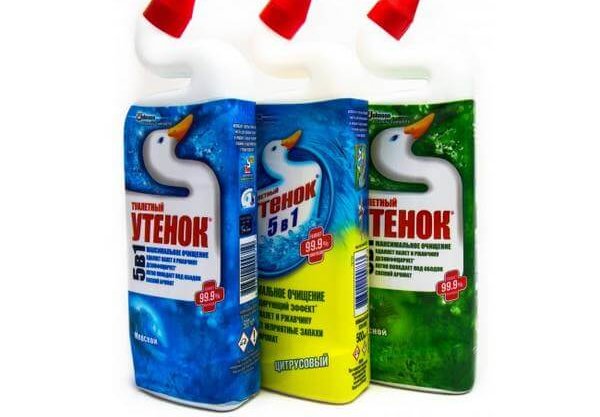
The following advantages can be noted:
- the presence of a spout that allows you to apply the product under the rim;
- pleasant aroma;
- affordable price;
- effective fight against bacteria;
- protective cap.
Flaws:
- The consistency is medium thick, which is why the product is consumed quite quickly.
- "Sanox Ultra". Enough good drug, it is produced by a domestic factory, which determines its low cost, and efficiency does not suffer from this at all. The active substance removes both rust and plaque well, and smells pretty good.
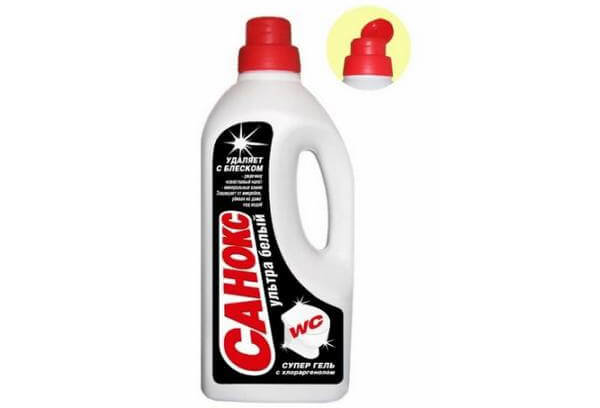
Advantages of Sanox Ultra:
- low price;
- effective work;
- presence of fragrance.
Disadvantages of the product:
- not too thick consistency;
- packaging that does not have child protection and a curved spout.
Cleaning the toilet with folk remedies
Hardware stores offer a variety of toilet cleaning products, which differ not only in their cost, but also in their level of effectiveness. Nevertheless, every housewife is quite capable of cleaning plumbing using available folk remedies that can be found in the house.
The following methods are recognized as the most popular in the fight for toilet cleanliness:
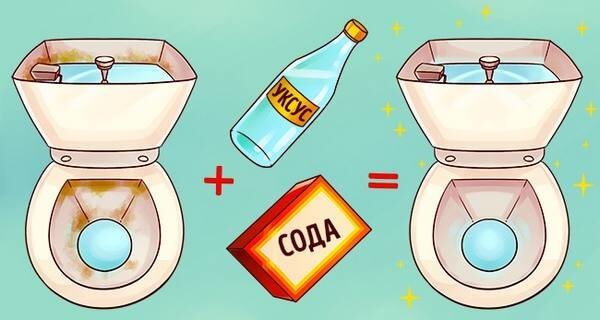
- Vinegar. The most common and gives excellent results due to the fact that it is an acid. It should be used as follows:
- apply to the walls and leave to act for a period of 20 to 30 minutes;
- rinse with plenty of water.
- Soda. It removes deposits and plaque well due to its abrasiveness. It must be applied to the walls of earthenware. In addition, it has the important ability to clean sewer drains.
- Lemon acid. Allows you to clean the surface of the toilet bowl easily and simply. It is enough to apply it to the surface, after which you can get rid of both the annoying plaque and most microbes.
- White. Contains chlorine and works great in cleaning the toilet. It must be applied in the evening so that the substance works throughout the night. After this, rinse the composition with water and do not worry about the presence of bacteria.
DIY toilet cleaner

Craftsmen have long developed their own toilet bowl cleaner, which can cope with various problems with maximum efficiency, including bacteria, dirt, plaque and bad smell, and at the same time costs very little. In addition, such a substance will be as safe as possible for people living in the house, especially if they have various kinds allergies, and pets.
How to cook it? Need to take some essential oils, vinegar, starch and salt. If the components are selected in the right quantity, you can hope to create a product that will perfectly cope with all the problems of plumbing and its care.
Creating a toilet cleaner involves the following steps:
- Place 3 teaspoons of coarse salt in a bowl and mix them with 3 tablespoons of starch.
- Add 1/2 cup of water to the resulting mixture, then mix everything thoroughly.
- Place the bowl on the stove and cook until thickened, constantly stirring its contents thoroughly.
- Remove the container from the heat and add 15 ml of vinegar and a little essential oil with any aroma.
- The mixture will be very thick, now you can form it into a ball, which you need to leave overnight, and then attach it to the toilet using wire or other improvised objects.
This completely simple procedure for preparing a toilet cleaner can please owners with excellent results at minimal cost.
In conclusion, it must be emphasized that with the modern assortment of goods in hardware stores that offer wide choose all kinds of cleaning products, it won’t be possible to clean the toilet great work. Nevertheless, regularly keeping it clean will minimize labor and costs, and will also preserve the comfort in your home and the health of its inhabitants.
Cleanliness of the toilet and toilet bowl is one of the main conditions for a comfortable life in any home. Few people like to ensure cleanliness in the toilet, but, unfortunately, this measure is forced, since it is there that pathogenic microbes and bacteria accumulate. Therefore, you should always clean the toilet in a timely manner. Now in household chemical stores you can find a lot detergents. But choosing the best toilet cleaner is not so easy, because each contains different chemical elements that can damage the structure of the toilet. The choice of a suitable cleaning product must be approached very responsibly, and in this article we will help you deal with this problem.
Main types of toilet contamination
Before you decide on the choice of toilet cleaner, you need to familiarize yourself with the main types of contamination:
- Limescale is formed as a result of the deposition of magnesium and calcium salts in water.
- Rust is formed due to high humidity.
- Contaminants on the surface - dust.
- Unpleasant odor - occurs as a result of blockages or improper use.
All these problems can be dealt with using special chemicals or improvised means.
Types of cleaning products
All preparations for cleaning the toilet can be divided into several groups. Let's look at the main types of detergents:
- To clean the outer surface, remove stains and dust.
- Chemicals that prevent contamination.
- Traditional methods in the fight against various types mud.
- Means for eliminating odor in the toilet.
Any of these products are effective in combating toilet contamination problems.
Surface cleaning products
The following chemicals are often used to remove stains from the surface of a toilet or urinal:
- Acid-based cleaners - oxalic acid and Toilet Duck. They are the most affordable and very effective in operation. Not a large number of Apply the substances to a soft dry cloth and wipe cistern and all other areas with dust and dirt.
- Abrasive preparations in powder form - apply a little product to a sponge and wipe the affected areas of the plumbing. It is not recommended to use such substances frequently, as they can damage the structure of the plumbing.
- Alkaline substances - bleach and bleach. They actively remove plaque and rust, and also provide good disinfection. The disadvantage of using such products is the strong and unpleasant odor, which is difficult to remove.
Important! When using all of the above, be sure to follow safety precautions. In addition, if the plumbing fixtures are made of artificial materials you will have to do without chlorine-containing preparations.
Remedies for blockages
Has everyone at least once encountered the problem of a clog in the bathroom or toilet? Clearing a clog is fairly easy if you have the right toilet cleaner on hand. The following household substances work well to remove blockages:
- Sterilized.
- Mister Muscle.
- Mole.
They work approximately the same way, so it is very difficult to say which one is the most effective. They work great on hair buildup and other types of organic material stuck in drains.
Use these toilet bowl cleaners as follows:
- Pour or pour the drug into the hole. We do this very carefully so that nothing gets on the skin.
- Leave for a certain amount of time (usually indicated in the instructions on the package).
- We flush the water or give it a few pushes with a plunger.
Important! Purchase an anti-clog product based on the materials the sewer pipes are made of.
How to make a safe toilet cleaner?
If it is not possible to purchase a special chemical for cleaning plumbing fixtures or you simply do not trust store-bought remedies, then you can make your own detergent.
To make a cleaning mixture, you will need available products that every person has:
- Salt.
- Vinegar.
- Potato starch.
- Flavored oil.
Let's start making a homemade cleaning product:
- Pour two tablespoons of salt and three tablespoons of potato starch into a bowl. We mix everything.
- Add a small amount of cool water. Mix thoroughly until creamy.
- Place the bowl over medium heat, stirring constantly until the mixture thickens.
- Turn off the fire. Let the mixture cool slightly, add a teaspoon of vinegar and a couple of drops of oil. Mix everything again.
- Pour the mixture into an ice tray to give it shape. Let it dry.
Important! These balls or cubes can be stored in the bathroom for up to three weeks. They are absolutely harmless and eliminate everything unpleasant odors. In addition, this homemade substance can be used to wipe tiles and plumbing fixtures.
Choosing which toilet cleaner is best is not very difficult. You just need to figure it out and determine the type of pollution, and then you can buy any suitable substance. Of course, products from household chemical stores are of high quality and reliability, but along with them there are store-bought products that are quite suitable for effective removal dirt in the bathroom.
When it comes to removing contaminants from plumbing fixtures, they are practically not inferior to special cleaning gels and powders. So, what will be useful to you:
- Carbonated drinks - Sprite and Cola. You should pour a liter of drink into the hole of the toilet or urinal and wait about two hours. Remove any remaining dirt with a brush.
- Citric acid works on the same principle as drinks. We fill the plumbing fixtures with citric acid and leave for some time. Afterwards, we wash it off and not a trace of dirt remains.
- Acetic acid - effectively removes limescale. It is necessary to pour a little acid into the urinal and then rinse it with running water.
Important! All of the products listed are much cheaper than special household preparations. Although the effectiveness is the same for both.
The best toilet cleaners
Based on reviews and a social survey of consumers, a rating of toilet and plumbing cleaning products was compiled. This information will be useful to you if you still decide to give preference to standard household chemicals:
- Silit Beng is a product based on hydrochloric acid. Actively copes with many types of pollution.
- Duckling - also contains hydrochloric acid. Available in the form of powders and gels. The most effective is the gel.
- Domestos - dissolves rust and urinary stone. The disadvantage of the product is the unpleasant odor and high aggressiveness.
- Comet - the product contains sulfuric acid.
Before choosing a particular product, familiarize yourself with its composition, advantages and disadvantages.
Criterias of choice
To purchase the best toilet cleaner, you should familiarize yourself with its capabilities. A good detergent, first of all, should:
- Provide a disinfectant antibacterial effect.
- No strong unpleasant odor.
- Effectively remove dirt from the surface of plumbing fixtures.
- Eliminate nauseating unpleasant odor.
- Remove lime deposits.
If the detergent copes with all this, then we can say that you have chosen a high-quality and reliable product.
Safety precautions when working with cleaning products
No matter what cleaning agent you use when cleaning the toilet, you should always follow these precautions:
- Wear rubber gloves.
- Be careful not to splash cleaning agent on your skin or eyes.
- If drops of the detergent product do get on your hands and mucous membranes, immediately rinse them with running water.
- Wear a protective mask and cover the drug with a lid to prevent unpleasant odors from entering the respiratory tract.
- Open the window to let the unpleasant smell out.
- Use the product according to the instructions on the package.
If you follow safety precautions and use the product correctly during cleaning, you can avoid serious consequences by ensuring perfect cleanliness in the toilet.
Our experts have tested in the laboratory the effectiveness of popular toilet products in the fight against limescale, rust and bacteria. According to the results of tests, multifunctional cleaning products are significantly inferior to toilet products.
Toilet cleaner is designed to remove dirt, limescale, rust, bacteria from the toilet bowl. On store shelves you can find a huge selection of products - gels, creams, powders, and the price can vary greatly depending on the form of release. What type of toilet cleaner is the most effective? Our Buyer's Guide will help answer these and other questions.
Advertising of all toilet cleaning products without exception makes you believe in their unconditional effectiveness. Which product will effectively remove dirt and disinfect the surface without harming the plumbing fixtures and your health? The site’s experts checked how much the manufacturers’ assurances correspond to the actual properties of toilet cleaning products.
We analyzed the range of toilet products in retail chains in 9 major cities and selected the most popular ones. Next, test samples were purchased from regular stores. Having studied leading practices in testing toilet cleaning products and surveying consumers, we came up with 4 main criteria by which each product was tested: rust removal, limescale removal, rate of plaque breakdown and disinfectant properties of the product. In addition, their density and consumption were assessed.
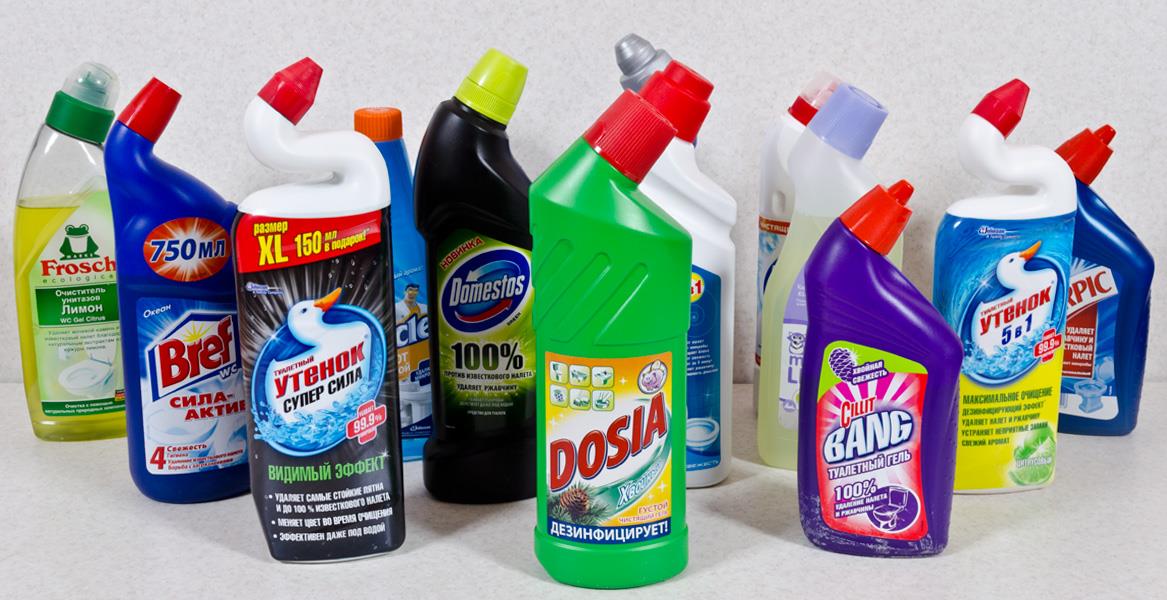
Test results
Price and quality
The high price of the product is not always justified. Thus, Amway Home Toilet Bowl Cleaner turned out to be the most expensive product in our tests (approx. 355 rubles for a 750 ml bottle). Despite the high price, according to the test results, it turned out to be average: in concentrated form, Amway toilet cleaner coped with limescale and rust a little better than most of the products we tested. In tests, the Amway product was significantly inferior in speed and the amount of plaque and rust removed to the inexpensive products Duckling 5 in 1 (approx. 76 rubles) and Duckling “Super Strength” (approx. 130 rubles). For this money you can buy several packages of toilet products whose effectiveness is better.
By the way, Utenok products became the best in terms of speed and amount of plaque and rust removal among the cleaning products we tested.
Disinfection
Some of the best disinfectant properties were those containing acids: Cillit Bang “Pine Fresh”, Harpic based on hydrochloric acid and Comet “Ocean” containing sulfuric acid. As strongly acidic agents, they can kill bacteria.
Universal means
Along with toilet cleaners, we also tested popular all-purpose cleaners. Based on the results obtained, Domestos “Ultra White”, Tyron, Dosia “Coniferous” products turned out to be outsiders in our rating. All three alkaline products did not cope well with limescale and rust, but showed good disinfectant properties due to the presence of sodium hypochlorite.
And having tested the most popular universal cleaning products on 5 types of stubborn stains with different surfaces, we came to the conclusion that any universal remedy will wash specific dirt worse than a special product. In pursuit of the properties of 5 in 1, 7 in 1, and even 10 in 1, the manufacturer often lowers the quality of the product to the minimum acceptable. As our tests show, most of these tools are just a marketing ploy.
You can find detailed test results in the rating of toilet products. The position of products in the rating does not depend on price, but is based only on test results.
You can familiarize yourself with the rules for using product test results presented on the website. .
The appearance of urinary stones and limescale is not a one-day process. It is unlikely to harm your health, but it is quite likely to harm sanitary ceramics. In addition, the sight of a dirty toilet can ruin the whole picture of your spotless bathroom. To find out how to clean a toilet from limescale and get rid of urinary stones, read our article. We have collected everything in it possible methods combating unwanted pollution.
Causes of deposits
In order to select the most effective method to combat deposits on sanitary ceramics, it is necessary to first find out the reasons for their appearance, composition, etc. The proverb “You need to know the enemy by sight” is also appropriate in our difficult task.

Plaque on the toilet not only spoils it appearance, but also destroys the enamel of the plumbing fixture
Limescale is a deposit of minerals that are found in excess in tap water, on the surface of ceramic and chrome-plated products. Mostly, pollution forms in flush areas in the form of yellow-orange smudges. Moreover, the more often the water is flushed in the toilet, the faster plaque forms.
Important! If deposits are not removed from the water supply nozzles in a timely manner, deposits can cause them to become clogged. Monitor the condition of each of your “home helpers”.
Urine stone is a deposit of mineral substances found in the human body. They are excreted along with urine and settle on the walls of the ceramic product. Combining with the minerals contained in the water, they form a dense and very unaesthetic layer of gray-yellow color. Irregularities in the ceramic coating aggravate and accelerate this process.
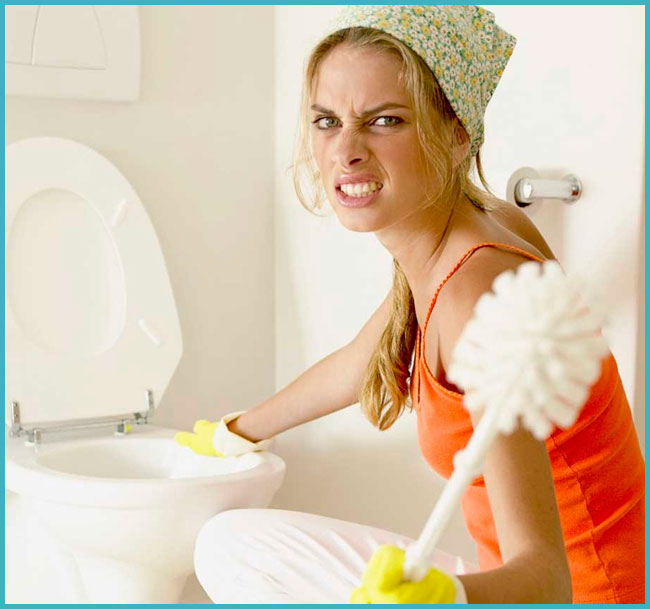
If the ceramics are initially of poor quality, then plaque will form on it faster due to the porosity of the material
When choosing sanitary ceramics, check the smoothness inner surface bowls. Ideal option is to purchase a product made from sanitary porcelain; unlike cheaper earthenware, it has a dense structure. This is achieved due to the increased temperature at which the product is fired. And it is the density that makes porcelain toilets smoother, and limescale does not eat into the structure of the ceramic, so it is much easier to clean it with your own hands.
It should be understood that sanitary porcelain is a material for the manufacture of luxury sanitary ware, and therefore its price is much higher than that of models made of earthenware. Whether to classify this feature as a disadvantage is up to each user to decide for themselves.

Porcelain toilet
The main reason for the appearance of deposits of any kind is the neglect of preventive methods for cleaning ceramics. It should be remembered that the more often the scheduled cleaning of the toilet room and the cleaning of plumbing is carried out, the longer the toilet remains in its original form.
To clean a ceramic product from limescale with your own hands, it is not necessary to run to the store and spend money on expensive chemicals. In addition, effective substances are expensive, and you don’t want to spend money on ineffective ones. In order to save yourself from unnecessary waste, and the toilet from limescale and urinary stone, you can use improvised means that any housewife always has in her arsenal. So, several methods of cleaning plumbing borrowed from the people.
Lemon acid
The main enemy of limescale is lemon acid. It very effectively fights deposits that have not reached their critical point.

Lemon acid - excellent remedy to remove plaque
To do this you need:
- purchase 3-4 sachets of the substance;
- apply to contaminated areas;
- close the toilet lid;
- wait 4-5 hours (preferably until morning);
- Rinse off the water, scrubbing thoroughly with a brush.
For greater efficiency you can repeat the procedure several times.
Acetic acid
Works the same as lemon. But to use it, vinegar essence must be prepared:
- measure 250 g of vinegar essence or food vinegar 9%;
- heat the liquid to 45-50 ° C (be sure to cover the container with a lid to avoid a pungent vinegar smell);
- pour warm vinegar into the toilet;

When working with acetic acid do not forget to protect the airway with a bandage
- You can add a little for effectiveness. baking soda(2-3 tsp);
- be sure to close the toilet bowl with a lid;
- leave for 2-3 hours or overnight.
In the morning, rinse the bowl thoroughly with water and rub it with a brush or other brush.
Oxalic acid
This product is fading into the background these days and is found on store shelves less and less often. But if you come across it on the modern market, feel free to buy it because it’s cheap and effective way restore the original whiteness of your ceramics. The product must be applied to a slightly damp soft cloth or sprinkled onto areas where stone and lime deposits have accumulated. There is no need to feel sorry for the substance. After treating areas where minerals have accumulated, clean with a brush and rinse thoroughly with clean water.
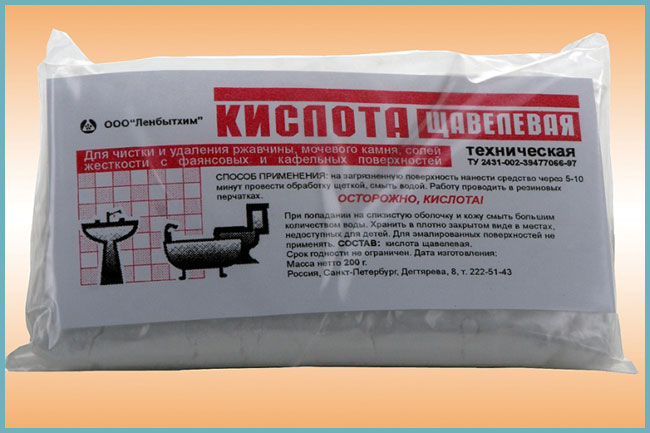
Oxalic acid will clean the surface of the toilet bowl in a short time
Baking soda
Everyone has this drug in their kitchen. Using soda, you can enhance the effect of acid, acetic or citric. Soda applied to contaminated areas destroys the structure of minerals and completely removes plaque from the surface ceramic products. To clean the toilet you will need at least 200 g (1 pack). For greater effectiveness, it is better to leave the drug to work overnight. In the morning, all that remains is to clean the bowl with a brush, removing any remaining mineral deposits.
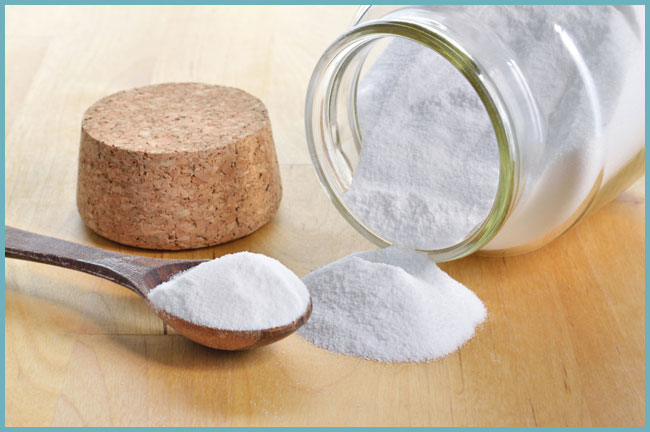
Coca Cola
No matter how strange it may sound, this wonderful drink can not only quench your thirst for a short time, but also remove old limescale deposits. To do this, pour 1-2 liters of liquid into the bowl and leave overnight. It is unknown how the cleaning properties of Cola were revealed; we can only assume that the drink was poured into the toilet by a caring mother, who subsequently discovered that it had “ate” all the sediment.
Important! Although the available products do not have a high concentration of acids or alkalis, you need to wear gloves when working with them. And when using vinegar, you need to take care of the respiratory tract.
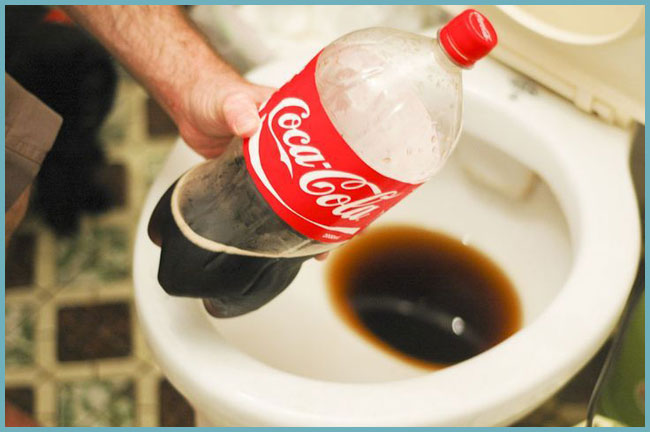
Some housewives even use Cola to remove plaque.
Chemistry guards purity
You can clean non-critical dirt with improvised substances. When limescale is more like the coating of a toilet bowl, and the formation of urinary stones has acquired a dark brown tint, folk remedies are useless. Only heavy artillery in the form of potent chemical cleaners can cope here.
Very important! With caustic chemicals It is necessary to work only with rubber gloves! Do not neglect safety when using!
For a comfortable and cozy life, regular cleaning of the apartment is required. Comfort and coziness in the toilet room especially depends on the condition of the room. In order for the cleanliness of the hygiene room to be impeccable, it is important to know which toilet product will help achieve best result as soon as possible. In this article we will look at the principle by which detergent is chosen for toilet room, as well as what are their main features.
Criteria for choosing toilet products
The product shelves of modern household chemical stores offer us a huge selection of toilet products from domestic and imported manufacturers. All of them differ not only in price, but also in shape, volume of production, and method of application.
What substance to choose so that cleaning this room is as easy as possible, and no less enjoyable?
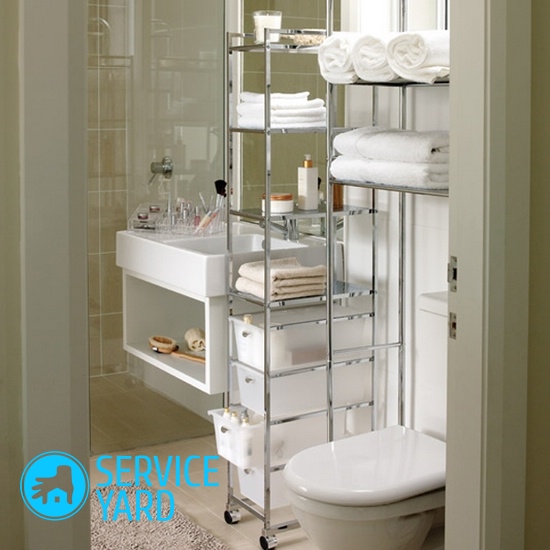 To get a truly high-quality result when minimum costs time and effort, a good toilet detergent should have the following properties:
To get a truly high-quality result when minimum costs time and effort, a good toilet detergent should have the following properties:
- Removing rust.
- Removing limescale deposits.
- The speed at which plaque disintegrates.
- Disinfection properties.
It is the level of these indicators that manufacturers pay attention to when testing and inventing new formulas of cleaning products.
How to choose a toilet cleaner?
When choosing a new toilet cleaner, you should consider that there are:
- special;
- preventive;
- universal toilet products;
- substances to remove blockages.
Types of household chemicals
The cleaning agents offered to us differ in the form of production, and therefore it is possible to choose the most suitable of the following options:
- Powder. It is very common to produce toilet detergent in the form of a cleaning powder. This substance is quite accessible and easy to use, but when buying a cleaning powder, you should take into account that the surfaces treated with it will have to be scrubbed very carefully using special brushes.
Important! With this treatment, you can damage and scratch the surface of plumbing fixtures and decorative finishing materials, which will ruin their appearance. In addition, such cleaning requires a lot of effort and time.
- Gel. Such toilet detergents have a thick gel structure, which is very convenient and economical to use. The special shape of the bottle allows you to apply the substance most effectively under the rim of the toilet bowl, after which the liquid gel, flowing evenly, is distributed along its walls. Thus, human contact with the active substance is minimized and there is no threat of caustic detergent coming into contact with the skin surface.
- Detergent in the form of a paste or cream. It performs gentle and gentle cleaning of contaminated surfaces, but does not always lead to the desired result.
Important! The quality of the result from using the paste very often depends on the manufacturer. Therefore, expensive products of this type often give excellent results without much effort.
- Liquid toilet detergent. Such products are quite effective for cleaning contaminants, but to achieve excellent results you have to apply a large amount of the substance. This leads to the fact that you have to buy the selected chemicals quite often, and therefore these are irrational expenses.
Toilet preventatives
 These types of detergents are not used for cleaning and cleaning the bathroom. They are designed to keep plumbing fixtures clean and fresh, as well as protect against serious, corrosive contaminants on the surface of the toilet walls.
These types of detergents are not used for cleaning and cleaning the bathroom. They are designed to keep plumbing fixtures clean and fresh, as well as protect against serious, corrosive contaminants on the surface of the toilet walls.
You can find the following preventive toilet products:
- Replaceable block. Often this plastic product, which is attached using a special clamp to the wall of the bathroom. Inside plastic block a special liquid, balls or toilet soap is placed. During each rinse, part of the substance is washed away, thereby protecting the surface from the accumulation of microorganisms, preventing the appearance of unpleasant plaque and creating a feeling of freshness and cleanliness.
- Stickers - easily cling to a dry surface, under the inner area of the toilet bowl. With each rinse, the active substance will create foam, which spreads a pleasant aroma throughout the room. This product is quite economical to use and protects against the accumulation of microbial foci.
- The magnetic ring is new to the cleaning products market. Place this device in the drain tank. The main purpose of the ring is to soften the water, which prevents salts from settling on the walls of the toilet bowl as plaque.
- Pills. This toilet cleaner, like the previous one, is dropped directly into the flush tank. When dissolved, it creates a pleasant aroma, removes plaque, and also disinfects after each rinse.
What modern tool should I use?
The shops household appliances They offer us a huge selection of different cleaning products for the toilet, but what kind of detergent should we buy in order to achieve the desired result as quickly as possible? Let's look at the most common examples of detergents:
- Active Toilet Duck is a detergent whose formula was developed specifically for cleaning bathroom surfaces. The active substance copes remarkably well with all types of contaminants, even in hard-to-reach and practically inaccessible places. After treating the toilet, a pleasant aroma will remain in the room.
- Bref - this manufacturer's detergent comes on the shelves in the form of gel, liquid detergent and powder. In addition to removing various contaminants, it has a disinfection and antibacterial effect.
- Sanitol is a specialized gel for cleaning plumbing fixtures, produced in Russia. This product is intended not only for treating the toilet, but also for washing tiles, sinks, bathtubs and other surfaces of the hygienic room.
- Domestos is a toilet detergent available in the form of a concentrated gel. Perfectly cleans, refreshes and disinfects the surface being treated.
- Cillit is great for removing rust and nasty deposits. Perfectly refreshes the room.
Important! When choosing several products for bathroom care, keep one thing in mind: important rule: Never mix products or apply one after another to surfaces. In this case, as a result of the specific chemical reaction, very corrosive fumes may be released. They damage not only the skin and open mucous membranes, but also the respiratory tract.
In any case, work with household chemicals and folk remedies, suitable for cleaning the bathroom, only wear protective gloves, and if necessary, use additional gauze bandages or a respirator.
We hope that now it is much easier for you to understand the entire huge range of toilet products and choosing the right one for you will not be difficult.








